KAOn Nuclear/Nuclei Interaction Studies
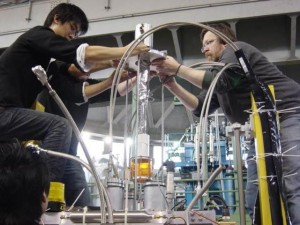
KAONNIS (KAOn Nuclear/Nuclei Interaction Studies) is an integrated initiative dedicated to the experimental studies of the low-energy kaon-nucleon and kaon-nuclei interactions.
The kaon meson contains the “strange” quark and its interaction with nucleons and nuclei involves the strong interaction described by the Quantum ChromoDynamics (QCD), which, at low energies, in a non-perturbative theory, due to the fact that interaction becomes stronger as the energy decreases. Various models were developed to study QCD at low-energy, among which: potential models, chiral perturbation theory and also lattice theory. All these models need experimental input to be checked and optimized and KAONNIS is providing such fundamental experiment input. The impact of our experimental results extend from nuclear and particle physics to astrophysics (equation of state of neutron stars).
KAONNIS include experimental studies of kaonic atoms, a type of exotic atoms where the electron is replaced by a negatively charged kaon, and nuclear interaction studies between kaons and nuclear matter.
The experimental studies are performed at the DAFNE collider at LNF-INFN and at the J-PARC complex in Japan. Since the main group activity is focussed on the kaonic atoms experiment at LNF-INFN (SIDDHARTA-2 experiment) in what follows a description of the group activity in the framework of SIDDHARTA-2 is given.
There are other activities within KAONNIS, such as: the AMADEUS kaon-nuclei studies (at DAFNE) and the kaon-nuclei interactions studies within various experiments at J-PARC (among which E15, E31, E57 ad E62), which are not described in detail.
The SIDDHARA-2 experiment
Scientific case: kaonic atoms in SIDDHARTA-2
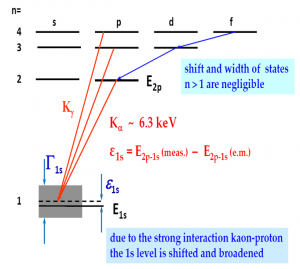
The SIDDHARTA-2 Collaboration aims to perform the first experiment of the kaonic deuterium transitions to the fundamental, 1s, level, to complete the SIDDHARTA measurement of kaonic hydrogen (A New Measurement of Kaonic Hydrogen X-rays, Phys.Lett. B704 (2011) 113-117), the most precise in the world, and allow to extract the antikaon-nucleon scattering lengths, which are fundamental quantities in low-energy QCD study.
A kaonic atom is formed when a negatively charged kaon enters a target, stops inside and replaces an electron in an atom, forming a highly excited (mass of the kaon much larger than the electron one) kaonic atom. The kaonic atom de-excites towards lower energy levels and emits radiation. When reaching the lowest level, 1s, the kaon interacts with the nucleus also by the strong interaction, which induces a shift and a broadening of the width of the level with respect to the purely electromagnetic calculated values. The X-ray transitions to the fundamental level aloe to extract the shift and width and these quantities are then related to low-energy QCD.
SIDDHARTA-2 aims to perform the first difficult measurement of kaonic deuterium X-ray transitions to the 1s level, by using the kaon beam generated by the DAFNE collider and newly X-ray Silicon Drift Detectors.
The SIDDHARTA-2 Collaboration
SIDDHARTA-2 is a broadly international collaboration among 12 Institutes coming from 8 countries (see the list of collaborators in https://www.actaphys.uj.edu.pl/fulltext?series=Reg&vol=51&page=251) with expertise in kaonic atoms, detection systems, cryogeny and vacuum, read-out electronics, data analyses and Monte Carlo simulations.
The SIDDHARTA-2 setup
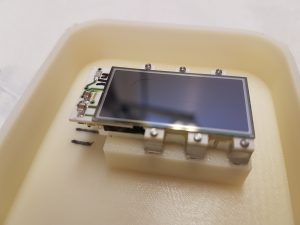
The SIDDHARTA-2 setup basically consists of a target filled with deuterium gas in cryogenic conditions, surrounded by Silicon Drift Detectors (SDD) specially developed to perform spectroscopic high precision measurements.
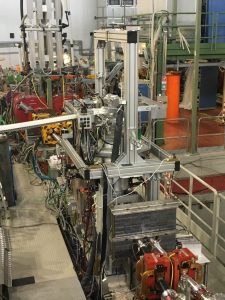
The setup is complemented by a trigger system based on scintillators read by Photo-Multipliers giving a trigger on the back-to-back generated kaons from the phi-decays, two veto systems for the background reduction and a shielding structure done mostly in lead to reduce the background.
The SIDDHARTA-2 setup in its first configuration, SIDDHARTINO, aiming to measure kaonic helium transitions to optimize the setup in the view of the kaonic deuterium measurement, is installed on DAFNE and presently in data taking.
SIDDHARTA-2 status and plans
After SIDDHARTINO will measure kaonis helium and the setup will be optimized from Signal/Background point of view, the full SIDDHARTA-2 setup will be installed on DAFNE and a period of data taking, aiming to collect an integrated luminosity of 800 pb**-1, 2ill follow in 2020-2021.
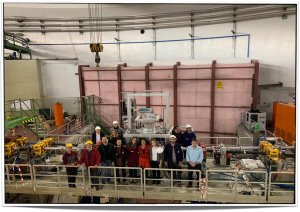
In parallel with the kaonic deuterium measurement by SIDDHARTA-2 the collaboration plans to perform feasibility measurements with a High Purity Germanium detector places aside, for other kaonic atoms measurements for future dedicated measurements after SIDDHARTA-2.
External support
SIDDHARTA-2 experiment is supported by external funding such as: the Austrian Science Fund (FWF), P24756-N20; the Austrian Federal291 Ministry of Science and Research (BMBWK), 650962/0001 VI/2/2009; the Croatian Science Foundation under292 project IP-2018-01-8570; the Ministero degli Affari Esteri e della Cooperazione Internazionale, Direzione Generale293 per la Promozione del Sistema Paese (MAECI), FWF project P33037-N “Measurement of Kaonic Deuterium X-ray294 Transitions”, EU STRONG-2020 project (Grant Agreement 824093) and Polish Ministry of Science and Higher295 Education through grant No. 7150/E-338/M/2018
Reference:
The modern era of light kaonic atom experiments, Catalina Curceanu et al, Rev.Mod.Phys. 91 (2019) no.2, 025006
 INFN-LNF Laboratori Nazionali di Frascati
INFN-LNF Laboratori Nazionali di Frascati